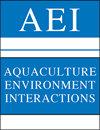沿海地区水产养殖海鳟风险评估方法的建立
IF 2.5
2区 农林科学
Q2 FISHERIES
引用次数: 5
摘要
挪威对水产养殖生产的监管考虑到了鲑鱼虱对野生鱼类的潜在影响。然而,大多数注意力都集中在对野生大西洋鲑鱼的影响上,尽管事实上溯河褐鳟的大部分海洋阶段都在沿海水域度过,而鲑鱼虱对沿海水域的影响最大。在本研究中,我们首先提出了海洋生活面积和海洋摄食时间的变化作为首次洄游的海鳟的可持续性指标,因为高鲑鱼虱密度可能会将海鳟排除在其他可用的栖息地之外,迫使它们提前返回淡水。此外,开发了一种基于生物流体动力学模型的方法来作为这些指标的代理。该方法计算了海鳟的大小、迁徙时间和空间范围,并在挪威2个鲑鱼养殖生产区Hardangerfjord (PO3)和romsdalsjord (PO5)以及每个峡湾内的2条焦点河流中进行了验证。基于这些比较,我们举例说明了PO3和PO5之间以及区域内海洋生物面积和海洋摄食时间的变化差异。晚入海(6月5日)的海鳟比早入海(4月24日)或中游(5月15日)的海鳟更容易受到虱子的影响。结果表明,鲑鱼虱对海鳟种群的潜在影响很大,且受时空因素的影响。考虑到鲑鱼虱对海鳟的负面影响,有必要从整体上看待水产养殖与依赖栖息地生产的野生物种之间的环境相互作用。本文章由计算机程序翻译,如有差异,请以英文原文为准。
Development of a risk assessment method for sea trout in coastal areas exploited for aquaculture
The regulation of aquaculture production in Norway considers the potential impact of salmon lice on wild fish. However, most attention has been focused on impacts on wild Atlantic salmon, despite the fact that anadromous brown trout spend the majority of their marine phase in coastal waters, where salmon lice have the highest impact. In the present study, we first suggest changes in marine living area and marine feeding time as sustainability indicators for first-time migrant sea trout, as high salmon lice densities may exclude sea trout from otherwise usable habitat and force them to return early to freshwater. Further, a method based on a bio-hydrodynamic model was developed to serve as a proxy for these indicators. The method accounted for the size, migration timing and spatial extent of sea trout and was demonstrated in 2 Norwegian salmon aquaculture production areas, Hardangerfjord (PO3) and Romsdalsfjord (PO5), and 2 focal rivers from within each fjord. Based on these comparisons, we exemplify how the change in marine living area and marine feeding time differed between PO3 and PO5 and within the areas. Sea trout migrating to sea late (June 5) were always more affected by lice than those migrating early (April 24) or at intermediate dates (May 15). Our estimates revealed dramatic potential impacts of salmon lice on sea trout populations, which were greatly influenced by spatial and temporal aspects. Considering the negative impacts of salmon lice on sea trout, a holistic view of environmental interactions between aquaculture and wild species that depend on habitats exploited for production is necessary.
求助全文
通过发布文献求助,成功后即可免费获取论文全文。
去求助
来源期刊

Aquaculture Environment Interactions
FISHERIES-MARINE & FRESHWATER BIOLOGY
CiteScore
4.90
自引率
13.60%
发文量
15
审稿时长
>12 weeks
期刊介绍:
AEI presents rigorously refereed and carefully selected Research Articles, Reviews and Notes, as well as Comments/Reply Comments (for details see MEPS 228:1), Theme Sections and Opinion Pieces. For details consult the Guidelines for Authors. Papers may be concerned with interactions between aquaculture and the environment from local to ecosystem scales, at all levels of organisation and investigation. Areas covered include:
-Pollution and nutrient inputs; bio-accumulation and impacts of chemical compounds used in aquaculture.
-Effects on benthic and pelagic assemblages or processes that are related to aquaculture activities.
-Interactions of wild fauna (invertebrates, fishes, birds, mammals) with aquaculture activities; genetic impacts on wild populations.
-Parasite and pathogen interactions between farmed and wild stocks.
-Comparisons of the environmental effects of traditional and organic aquaculture.
-Introductions of alien species; escape and intentional releases (seeding) of cultured organisms into the wild.
-Effects of capture-based aquaculture (ranching).
-Interactions of aquaculture installations with biofouling organisms and consequences of biofouling control measures.
-Integrated multi-trophic aquaculture; comparisons of re-circulation and ‘open’ systems.
-Effects of climate change and environmental variability on aquaculture activities.
-Modelling of aquaculture–environment interactions; assessment of carrying capacity.
-Interactions between aquaculture and other industries (e.g. tourism, fisheries, transport).
-Policy and practice of aquaculture regulation directed towards environmental management; site selection, spatial planning, Integrated Coastal Zone Management, and eco-ethics.
 求助内容:
求助内容: 应助结果提醒方式:
应助结果提醒方式:


